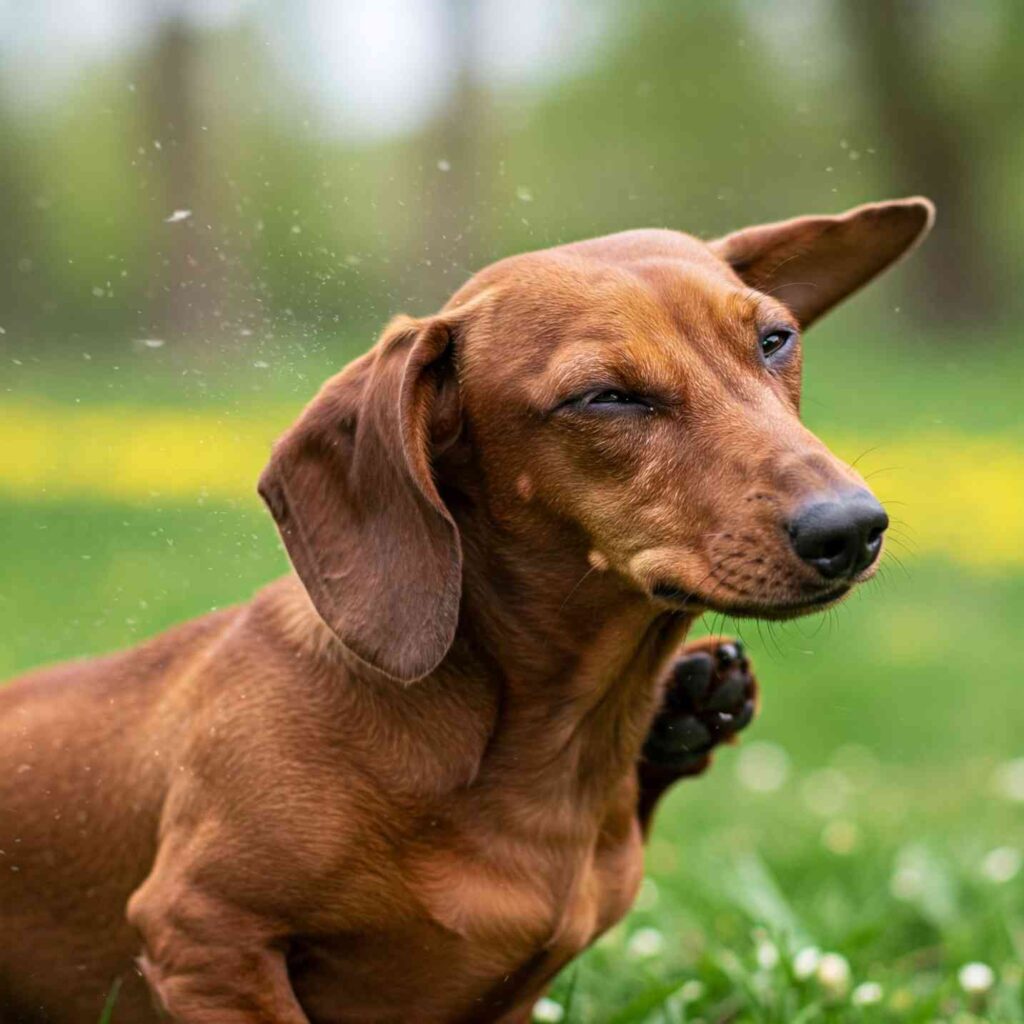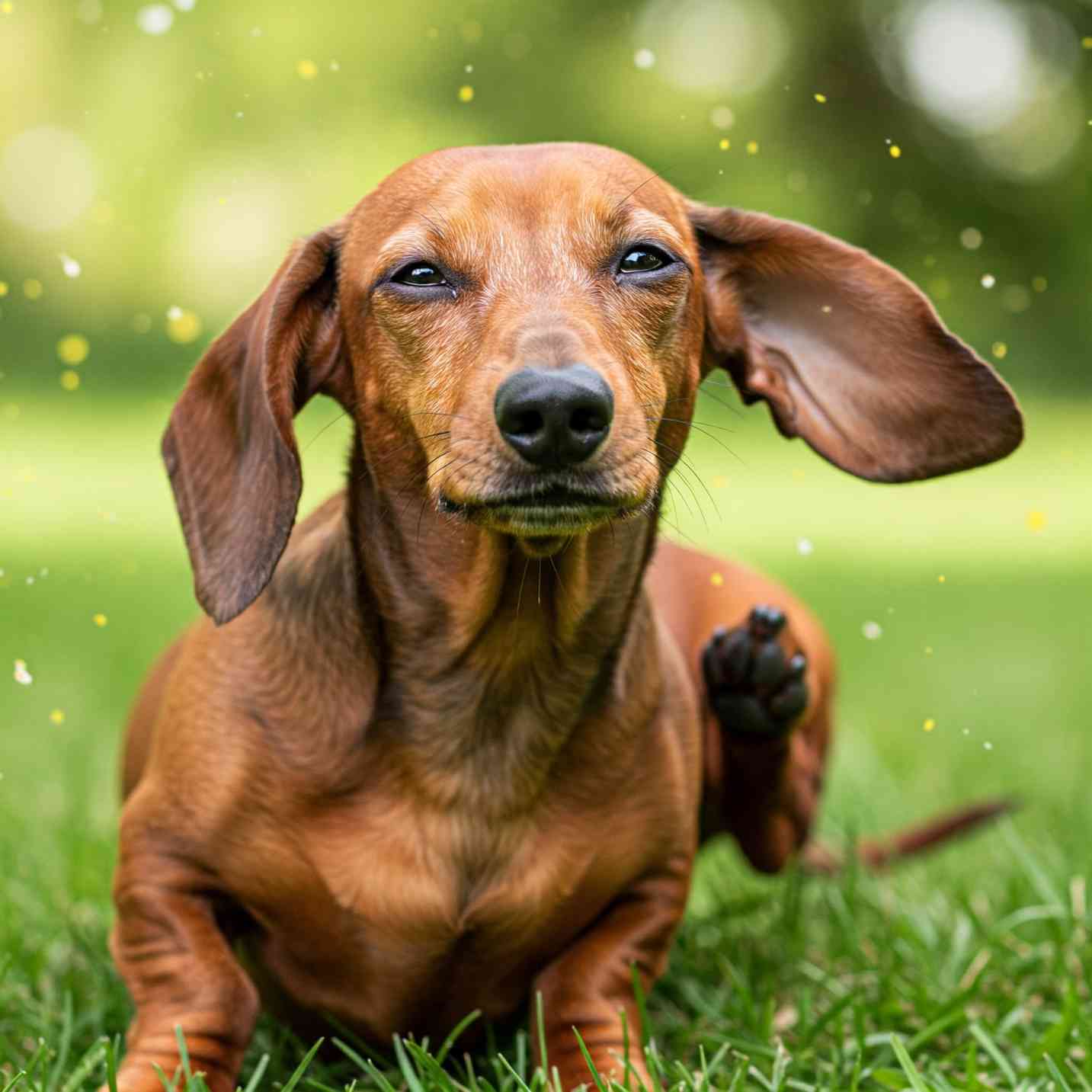Dachshund seasonal allergies are infections that occur when seasons change, especially in spring, summer, and fall. It happens when your dog’s immune system or skin reacts with things in the outer environment, like grass pollen, weed pollen, or mould spores. It can be annoying for your dog.
In today’s blog, I will guide how to get rid of dachshund seasonal allergies. I have also faced this issue many times with my sausage dog.
Here are seasonal dachshund allergy symptoms in dachshunds

When your Dachshund has seasonal allergies, they may start showing a variety of skin, paw, and ear and eyes related signs and symptoms because allergens react with this. It is important to recognise these signs in time and provide the proper treatment to ensure their comfort and well-being.
Itchy skin: These symptoms are seen when your dog is in the first stage of seasonal allergies. At this time, they scratch their skin excessively. Red bumps appear on the skin around the belly area, resembling a rash and possibly indicating an infection.
My dog also used to do it when he had this problem. He is also used to scratching a lot during this time, and the itching was so intense that it almost caused wounds.
Licking or chewing paws: Their skin and paws become dry and itchy, causing them to lick their paws excessively due to irritation. In this condition, your dog keeps licking its paws as if something is stuck on them. This is also one of the most commonly seen symptoms in seasonal allergies.
Ear infections: Ear infections can also appear as a result of seasonal allergies because your dog’s ears can react to environmental triggers like grass pollen, weed pollen, or mould spores. This causes redness around the ears, and your dog may scratch or rub them frequently due to the irritation.
When my dachshund had allergies, he would excessively scratch his ears using his paws to get relief from the constant itching.
Watery or red eyes: When a dachshund’s eyes react with grass pollen or mould, the eyes become irritated and red due to irritation.
Sneezing or runny nose: During seasonal allergies, a dachshund’s nose reacts to airborne particles like grass pollen, weed pollen, or mould spores. These allergens irritate their nose, and as a result, the dog is often seen sneezing.
Hair loss: When our dachshund has seasonal allergies, hair loss is also a common symptom. This is because the allergies make their skin dry and itchy, and the dryness can lead to hair loss.
Excessive grooming: When their skin becomes itchy, they tend to scratch themselves a lot, frequently chew on their paws, and exhibit excessive licking or biting.
Restlessness or discomfort: The feeling of unwellness in seasonal allergies makes your dog restless and discomfort.
How are seasonal allergies treated in dachshunds?
Identify the Allergen: It is important to know during which season your Dachshund shows symptoms of allergies to help identify the allergen. This helps narrow down the possible allergens.
For example, let’s say you noticed your dog had itchy skin during the summer. This helped you narrow down the possible allergens that could be affecting your dog. One common summer allergen is grass. Identifying this makes it easier to understand which specific allergen might be causing your dog’s allergies.
To accurately identify the cause, you can also have your dog tested for allergies directly through a veterinarian.
Minimise Exposure: Once we identify the allergen, we should make every effort to keep our Dachshund as far away from it as possible and minimise exposure. Some time ago, my Dachshund had allergies to grass, so I avoided letting him go near grass. Similarly, once you identify what your Dachshund is allergic to, you should keep them away from allergens.
Bathing and Grooming: Bathing and grooming your dog also play an important role in reducing allergies. If you regularly bathe and groom a dog with allergies, it helps remove allergens from their body.
Medications and Supplements: You should use grooming along with medication and some essential supplements for your Dachshund, as allergies or nutritional deficiencies can sometimes be the cause of health issues.
Regular Veterinary Check-ups: Even after following all the steps mentioned above, it is important to regularly visit the veterinarian for check-ups or to seek advice from time to time.
Only a qualified vet can determine the cause of your dachshund’s symptoms and recommend the appropriate course of action.
The symptoms described, such as excessive grooming, hair loss, itchy skin, or watery eyes, may also be indicative of other serious health conditions. Before starting any treatment, it is important to consult your veterinarian for a proper diagnosis and advice.
Conclusion
Dachshund seasonal allergies are very common when the season changes. They mainly happen when grass pollen, weed pollen, or mould spores react with the body’s immune system. We need to treat their seasonal allergies by minimizing their exposure to allergens. By reducing exposure to grass and other outdoor environmental factors, we can effectively cure their seasonal allergies.

